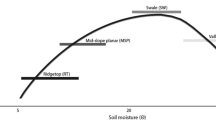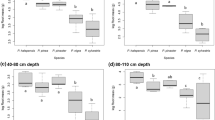Abstract
Background and aims
The way in which roots distribute throughout the critical zone influences soil and critical zone formation, as well as water, nutrient and energy fluxes. Root distributions, however, are also influenced by how the critical zone functions. Rapid vegetation changes offer a valuable setting to disentangle these reciprocal effects, and to observe the early changes that occur in the critical zone and how this affects its evolution.
Methods
We took advantage of recent exotic Pinus elliottii stands established over native mountain grasslands, to compare how roots of contrasting plant life forms occupy the soil-saprolite-rock continuum. We combined root count and biomass measurements across 2-m-deep observation pits into the saprolite, coupled with topsoil removal plots describing the coarse root transport system introduced by pines.
Results
Pine stands had four-fold more root biomass than grasslands (1.74 vs 0.41 kg of dry matter per square meter) and allocated a greater proportion of their fine roots into the saprolite. Pines also developed a coarse root transport system with profuse superficial lateral roots and irregularly distributed sinker roots occupying deep cracks for the first time.
Conclusion
The establishment of exotic pines over grasslands reshaped and expanded the root zone in only four decades, highlighting the capacity of vegetation to rapidly change the occupancy and dynamics of the critical zone.






Similar content being viewed by others
Data availability
Data available will be made available upon manuscript acceptance.
References
Anderson SP (2019) Breaking it down: mechanical processes in the weathering engine. Elem An Int Mag Mineral Geochem Petrol 15:247–252
Bardgett RD, Mommer L, De Vries FT (2014) Going underground: root traits as drivers of ecosystem processes. Trends Ecol Evol 29:692–699
Berhongaray G, King JS, Janssens IA, Ceulemans R (2013) An optimized fine root sampling methodology balancing accuracy and time investment. Plant Soil 366:351–361
Bodner G, Leitner D, Kaul H-P (2014) Coarse and fine root plants affect pore size distributions differently. Plant Soil 380:133–151
Brantley SL, Eissenstat DM, Marshall JA, Godsey SE, Balogh-Brunstad Z, Karwan DL, Papuga SA, Roering J, Dawson TE, Evaristo J (2017) Reviews and syntheses: on the roles trees play in building and plumbing the critical zone. Biogeosciences 14(22):5115–5142
Cabido M, Ateca N, Astegiano ME, Anton AM (1997) Distribution of C3 and C4 grasses along an altitudinal gradient in Central Argentina. J Biogeogr 24:197–204. https://doi.org/10.1046/j.1365-2699.1997.00085.x
Casper BB, Schenk HJ, Jackson RB (2003) Defining a plant’s belowground zone of influence. Ecology 84:2313–2321
Cheng J, Zhang H, Wang W, Zhang Y, Chen Y (2011) Changes in preferential flow path distribution and its affecting factors in southwest China. Soil Sci 176:652–660
Cingolani AM, Vaieretti MV, Giorgis MA, La Torre N, Whitworth-Hulse JI, Renison D (2013) Can livestock and fires convert the sub-tropical mountain rangelands of central Argentina into a rocky desert? Rangel J 35:285–297. https://doi.org/10.1071/RJ12095
Dawson TE, Hahm WJ, Crutchfield-Peters K (2020) Digging deeper: what the critical zone perspective adds to the study of plant ecophysiology. New Phytol 226:666–671
De Deyn GB, Cornelissen JHC, Bardgett RD (2008) Plant functional traits and soil carbon sequestration in contrasting biomes. Ecol Lett 11:516–531
Fan Y, Miguez-Macho G, Jobbágy EG, Jackson RB, Otero-Casal C (2017) Hydrologic regulation of plant rooting depth. Proc Natl Acad Sci 114:10572–10577
Ferrara, C., Salvati, L., Barone, P.M., 2017. Tree root system imaging using Ground Penetrating Radar. Ann Silvicult Res 41:80–83. https://doi.org/10.12899/asr-1314
Germon A, Laclau J-P, Robin A, Jourdan C (2020) Tamm Review: Deep fine roots in forest ecosystems: Why dig deeper? For Ecol Manage 466:118135
Gregory PJ (2022) Are plant roots only “in” soil or are they “of” it? Roots, soil formation and function. Eur J Soil Sci 73:e13219
Hijmans RJ, Ghosh A (2021) Raster: Geographic Data Analysis and Modeling. R package version 3.4–10. https://CRAN.R-project.org/package=raster
Hollander M, Wolfe D (1973) The one way out. Non Parametric Statistical Methods. John Wiley Sons, New York, pp 15–132
Izurieta G, Abud D, Izaurralde J (1993) Plantaciones de Pinos de la Provincia de Córdoba. Congreso Forestal Argentino y Latinoamericano, p 103
Jackson RB, Canadell J, Ehleringer JR, Mooney HA, Sala OE, Schulze E-D (1996) A global analysis of root distributions for terrestrial biomes. Oecologia 108:389–411
Jobbágy EG, Acosta AM, Nosetto MD (2013) Water yield in primary watersheds under grasslands and pine plantations in the hills of Córdoba (Argentina). Ecología Austral 23(02):087–096
Johnson MS, Lehmann J (2006) Double-funneling of trees: Stemflow and root-induced preferential flow. Ecoscience 13:324–333
Kan X, Cheng J, Hu X, Zhu F, Li M (2019) Effects of grass and forests and the infiltration amount on preferential flow in karst regions of China. Water 11:1634
Kulmatiski A, Beard KH, Holdrege MC, February EC (2020) Small differences in root distributions allow resource niche partitioning. Ecol Evol 10:9776–9787
Lucas M, Schlüter S, Vogel H-J, Vetterlein D (2019) Roots compact the surrounding soil depending on the structures they encounter. Sci Rep 9. https://doi.org/10.1038/s41598-019-52665-w
Malik I, Pawlik Ł, Ślęzak A, Wistuba M (2019) A study of the wood anatomy of Picea abies roots and their role in biomechanical weathering of rock cracks. Catena 173:264–275 https://doi.org/10.1016/j.catena.2018.10.018
Menghi M, Cabido M, Peco B, Pineda FD (1989) Grassland heterogeneity in relation to lithology and geomorphology in the Córdoba Mountains, Argentina. Vegetatio 84:133–142
Milani T, Jobbágy EG, Nuñez MA, Ferrero ME, Baldi G, Teste FP (2020) Stealth invasions on the rise: rapid long-distance establishment of exotic pines in mountain grasslands of Argentina. Biol Invasions 22:2989–3001
Nie Y, Chen H, Wang K, Ding Y (2014) Rooting characteristics of two widely distributed woody plant species growing in different karst habitats of southwest China. Plant Ecol 215:1099–1109
Nosetto MD, Jobbágy EG, Paruelo JM (2006) Carbon sequestration in semi-arid rangelands: comparison of Pinus ponderosa plantations and grazing exclusion in NW Patagonia. J Arid Environ 67:142–156
Pawlik Ł, Kasprzak M (2018) Regolith properties under trees and the biomechanical effects caused by tree root systems as recognized by electrical resistivity tomography (ERT). Geomorphology 300:1–12
Pawlik Ł, Phillips JD, Šamonil P (2016a) Roots, rock, and regolith: Biomechanical and biochemical weathering by trees and its impact on hillslopes-A critical literature review. Earth-Sci Rev 159:142–159. https://doi.org/10.1016/j.earscirev.2016.06.002
Pawlik Ł, Phillips JD, Šamonil P (2016b) Roots, rock, and regolith: Biomechanical and biochemical weathering by trees and its impact on hillslopes—A critical literature review. Earth-Sci Rev 159:142–159
Phillips JD, Marion DA (2004) Pedological memory in forest soil development. For Ecol Manage 188:363–380
Phillips JD, Pawlik Ł, Šamonil P (2019) Weathering fronts. Earth-Sci Rev 198:102925
Poca M, Cingolani AM, Gurvich DE, Saur Palmieri V, Bertone G (2018) Water storage dynamics across different types of vegetated patches in rocky highlands of central Argentina. Ecohydrology 11:e1981
Poot P, Hopper SD, van Diggelen JMH (2012) Exploring rock fissures: does a specialized root morphology explain endemism on granite outcrops? Ann Bot 110:291–300
Poot P, Lambers H (2008) Shallow-soil endemics: adaptive advantages and constraints of a specialized root-system morphology. New Phytol 178:371–381
Pransiska Y, Triadiati T, Tjitrosoedirjo S, Hertel D, Kotowska MM (2016) Forest conversion impacts on the fine and coarse root system, and soil organic matter in tropical lowlands of Sumatera (Indonesia). For Ecol Manage 379:288–298
Richter D de B, Mobley ML (2009) Monitoring Earth’s critical zone. Science (80-. ) 326:1067–1068
Richter DD, Markewitz D (1995) How deep is soil? Bioscience 45:600–609
Schenk HJ, Jackson RB (2002) The global biogeography of roots. Ecol Monogr 72:311–328. https://doi.org/10.1890/0012-9615(2002)072[0311:TGBOR]2.0.CO;2
Simpson C, Law RD, Gromet LP, Miro R, Northrup CJ (2003) Paleozoic deformation in the Sierras de Córdoba and Sierra de las Minas, eastern Sierras Pampeanas, Argentina. J South Am Earth Sci 15:749–764
Stone EL, Kalisz PJ (1991) On the maximum extent of tree roots. For Ecol Manage 46:59–102. https://doi.org/10.1016/0378-1127(91)90245-Q
Tumber-Dávila SJ, Schenk HJ, Du E, Jackson RB (2022) Plant sizes and shapes above and belowground and their interactions with climate. New Phytol 235:1032–1056. https://doi.org/10.1111/nph.18031
Wakeling JL, Bond WJ, Ghaui M, February EC (2015) Grass competition and the savanna-grassland ‘treeline’: A question of root gaps? South African. J Bot 101:91–97
Weemstra M, Mommer L, Visser EJW, van Ruijven J, Kuyper TW, Mohren GMJ, Sterck FJ (2016) Towards a multidimensional root trait framework: a tree root review. New Phytol 211:1159–1169
Wendel AS, Bauke SL, Amelung W, Knief C (2022) Root-rhizosphere-soil interactions in biopores. Plant Soil 475:253–277
Wickham H (2016) ggplot2: Elegant Graphics for Data Analysis. Springer-Verlag New York
Wickham H, Henry L (2019) tidyr: Tidy Messy Data. R package version 1.1.0. https://CRAN.R-project.org/package=tidyr
Wu G-L, Cui Z, Huang Z (2021) Contribution of root decay process on soil infiltration capacity and soil water replenishment of planted forestland in semi-arid regions. Geoderma 404. https://doi.org/10.1016/j.geoderma.2021.115289
Acknowledgements
We especially thank to F. Spalazzi, S. Alsina, M. Almonacid and R. Paez for their valuable help during root excavations in the field. We also thank to O. Gonzales and N. Medina for their kind assistance during the field work.
Funding
Funding was provided by a National Geographic Small Grant granted to F.P.T (NGS-163R-18).
Author information
Authors and Affiliations
Contributions
TM, FPT and EGJ conceived the ideas and designed methodology; TM collected the data; TM, FPT and EGJ analyzed the data; TM led the writing of the manuscript. All authors contributed critically to the drafts and gave final approval for publication.
Corresponding author
Ethics declarations
Competing interest
The authors have no relevant financial or non-financial interests to disclose.
Additional information
Responsible Editor: W Richard Whalley.
Publisher's Note
Springer Nature remains neutral with regard to jurisdictional claims in published maps and institutional affiliations.
Supplementary Information
Below is the link to the electronic supplementary material.
Rights and permissions
Springer Nature or its licensor (e.g. a society or other partner) holds exclusive rights to this article under a publishing agreement with the author(s) or other rightsholder(s); author self-archiving of the accepted manuscript version of this article is solely governed by the terms of such publishing agreement and applicable law.
About this article
Cite this article
Milani, T., Teste, F.P. & Jobbágy, E.G. Incipient reshaping of the critical zone of native mountain grasslands caused by exotic pines. Plant Soil 495, 601–613 (2024). https://doi.org/10.1007/s11104-023-06350-7
Received:
Accepted:
Published:
Issue Date:
DOI: https://doi.org/10.1007/s11104-023-06350-7




